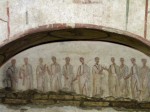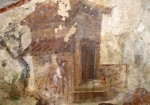 The Hypogeum of the Aurelii is a catacomb built for the important Aurelii family during the early third century A.D. It was discovered in November 1919 by construction workers building a body shop (now a large car dealership) on Viale Manzoni, near the Basilica of the Holy Cross in Jerusalem on the Esquiline hill in Rome. The frescoes drew academic attention because of their copious use of both traditional Greco-Roman polytheistic imagery — Hermes, Hercules, Prometheus, Penelope’s suitors — and early Christian iconography — a Latin cross, the Good Shepherd, eleven men in togas (probably apostles), the creation of Adam. Scholars have been speculating ever since about what kind of theology these frescoes were depicting, perhaps a personal syncretistic combination of Christianity and paganism espoused by the Aurelii of this era, perhaps full-on paganism only decorated with some elements of the up-and-coming Christian culture, perhaps a form of dissident Gnosticism with its own unique symbolic imagery.
The Hypogeum of the Aurelii is a catacomb built for the important Aurelii family during the early third century A.D. It was discovered in November 1919 by construction workers building a body shop (now a large car dealership) on Viale Manzoni, near the Basilica of the Holy Cross in Jerusalem on the Esquiline hill in Rome. The frescoes drew academic attention because of their copious use of both traditional Greco-Roman polytheistic imagery — Hermes, Hercules, Prometheus, Penelope’s suitors — and early Christian iconography — a Latin cross, the Good Shepherd, eleven men in togas (probably apostles), the creation of Adam. Scholars have been speculating ever since about what kind of theology these frescoes were depicting, perhaps a personal syncretistic combination of Christianity and paganism espoused by the Aurelii of this era, perhaps full-on paganism only decorated with some elements of the up-and-coming Christian culture, perhaps a form of dissident Gnosticism with its own unique symbolic imagery.
The arguments underscore what a historically significant find this is, representing as it does the multicultural milieu of a time and place in which a myriad of religions from a variety of Christian sects to Mithraism to paganism all wrestled with and bounced off each other. The Pontifical Commission for Sacred Archeology, the office of the Vatican responsible for the restoration of the hypogeum, presents the artwork as capturing the transition from paganism to Christianity — “the parabola of Christianization,” according to Cardinal Gianfranco Ravasi, president of the Pontifical Commission — but I think that’s an oversimplification. There weren’t just two strains of temporally overlapping thought here.
The Aurelii were a very prominent and wealthy plebian family in the Roman Republic. They had consuls in the family starting with the First Punic War in the mid-second century B.C. Aurelia Cotta was Gaius Julius Caesar’s mother. In the imperial era, Marcus Aurelius was the most famous of the Aurelii. We don’t know if the builders of the hypogeum were of the imperial line. Manumitted slaves took the gens of their former owners so it could be freedmen, but even so by this time imperial freedmen could be extremely wealthy, politically powerful and socially respected. Enough to be able to afford large and elaborately decorated burial chambers.
 The laser technology used during the ten-year restoration to clean the walls (the same technology that was used in the restoration of the catacombs of St. Tecla) has revealed a newly-discovered fresco depicting the death of two brothers, Onesimus Aurelius and Aurelius Papirius, and their sister Aurelia Prima mourning them, all bound with Homeric imagery.
The laser technology used during the ten-year restoration to clean the walls (the same technology that was used in the restoration of the catacombs of St. Tecla) has revealed a newly-discovered fresco depicting the death of two brothers, Onesimus Aurelius and Aurelius Papirius, and their sister Aurelia Prima mourning them, all bound with Homeric imagery.
At the top, where the icon painters of the past recognized the palace and the flocks of Laertes, was discovered Aurelia Prima who, in a sign of mourning, lets down her hair to mourn the two dead brothers who have been placed on the bier in a funerary enclosure. In the lower area …, we see the moment when Odysseus gets Circe to return his comrades, transformed into swine [by her sorcery], back into human form. The story, which unfolds in the tenth canto of the Odyssey, fits well with the funerary themes of the period, keeping in mind that it was Circe who showed a curious Odysseus the pathway to the underworld. The new scenes fall perfectly in the multi-religious system headed by the Aurelii’s personal syncretism, which also involves two enigmatic scenes where you can recognize both Prometheus creating man and Hercules in the garden of the Hesperides, and the creation of Adam and the expulsion from Eden.
It is likely that the three named Aurelii were among those buried in the chambers. In an inscribed marble plaque, Aurelius Martinus and his wife Julia Lydia memorialize their deceased daughter Aurelia Myrsina. The frescoes suggest that these Aurelii wanted to present themselves as members of an imperial elite who were entitled to depict themselves along with gods and demigods in the midst of mythological themes. Their villas and gardens, concrete representations of wealth, are the settings of some of these scenes, including the one of Aurelia Prima mourning her brothers.
In order to preserve the delicate frescoes, the hypogeum will not be open to general tourism, but it won’t be closed all the way either. Any would-be tourists will have to book a visit ahead of time with the pontifical commission.
[youtube=http://www.youtube.com/watch?v=ffkJvHxUhPA&feature=player_embedded&w=430]
Third century BC: Gaius Aurelius L. f. C. n. Cotta, consul in 252 and 248 BC, during the First Punic War. (Wikipedia article on the Aurelia gens.)
Aurelia Cotta (21 May 120 BC – 31 July 54 BC) was unimaginatively named, as she was a member of the family Aurelia Cotta.
Aurelia Cotta’s mother was Rutilia of gens Rutilia, family Rutilia Rufus.
Gildas’s British hero Ambrosius Aurelianus might have been of gens Aurelia. The alternative form “Aurelius Ambrosius” makes sense given that the hypogeum of the Aurelii indicates that by the third century AD “Aurelius” could be placed either first or last in a person’s name.